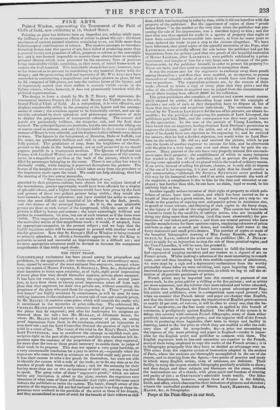FINE ARTS.
Painted Window, representing the Tournament of the Field of Cloth of Gold, now exhibiting at 15, Oxford Street.
Painting on glass has hitherto been an imperfect art, relying solely upon the brilliancy of its transparent effects of colour to please the eye : the finest specimens of ancient painted windows remaining to us, are little more than kaleidoscopical combinations of colours. The modern attempts to introduce historical design into this species of art, have failed of .producing more than a general beauty and grandeur of effect, gorgeous or solemn as the case might lie; mid it was deemed impossible to remove those obstructions to complete pictorial illusion which were presented by the necessary lines of junction being unavoidably visible, consisting, as they must, of metal frame-work to sustain the frail material. This limn idable obstacle has now, however, been so far removed as to prevent its interfering in any material degree with the design ; and the persevering skill and ingenuity of Mr. WILMSHURST have succeeded in constructing a magnificent and unique picture on glass, 24 feet by 18, composed of 350 pieces, cut into the various forms of the figures, and so ingeniously united that their outline is scarcely visible except in the lighter colours, where, however, it does not prominently interfere with the pictorial representation.
The design is from a sketch by Mr. R. T. BONE, and represents the tournament between Francis the First and Henry the Eighth on the cele- brated Field of Cloth of Gold. As a composition, it is very effective, and displays considerable ability in the grouping of the figures and the arrange- ments of colour ; the costumes appear to be historically correct, and are ad- mirably calculated by their splendour and picturesque quaintness of style to display the gorgeousness of transparent colouring. The armour and jewels are particularly brilliant, the draperies rich, and the flesh tints natural. The principal figures are portraits, but the two monarchs tilting are of course cased in armour, and only ditAinguishable by their crests : the gold armour of Henry is very splendid, and the feathers in their helmets seem almost to wave. The figures in the foreground, of Brandon, Duke of Suffolk, and his sister, are particularly brilliant and rich in colouring, and are beauti- fully painted. The, gradations of tone, from the brightness of the fore- ground to the shade in the background, are as well preserved as we should suppose possible in a transparent medium. The Queens of England and France with Cardinal Wolsey are foremost of the spectators of the tourna- ment, in a magnificent pavilion at the back of the picture, which is well filled by personages belonging to the scene. There is not a face but what is distinctly visible, while keeping is preserved throughout the picture. The horses of the knights are to small ; which takes away from the grandenr of the impression made upon the mind. We could not help thinking, that had the meeting of the two young monarchs,
" Those suns of glory, those two lights of men,"
attended by their gorgeous retinue, been chosen for the subject instead of the tournament, greater opportunity would have been afforded for a display of splendid colours, and a higher interest would have been given by the faces and persons of those two gallant princes being visible ; they would also have formed a nucleus of splendour, andhave enabled the artist to concen- trate the most difficult and beautiful of his effects in the flesh, jewels, and rich dresses of the principal figures. As it is, the most admirable groups are those at each corner of the foreground, while the centre of the picture is filled by horses and armour ; the latter exceedingly brilliant and perfect in resemblance, 'tis true, but not of such interest as if the faces were visible. This suggestion, however, is not made with a view to detract from the unrivalled merits of this magnificent work : it would, if adopted, form an appropriate companion to the present subject ; and we hope that the highly ingenious artist will be encouraged to proceed with another work of similar grandeur. Now that St. George's Hall at Windsor is being restored to princely splendour, it affords a favourable opportunity for the King to patronize so novel and successful an improvement in a difficult art ; and no more appropriate ornament could be devised to increase the sumptuous magnificence of, that truly regal abode.


















 Previous page
Previous page